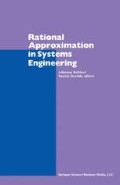Abstract
A problem on optimal approximation of continuous-time linear systems is studied. The performance measure (error) is chosen to be the spectral norm of the difference between the Hankel operators associated with the original system and the approximant. It is shown that the Hankel operators associated with continuous-time systems and the Hankel matrices associated with discrete-time systems are related by an interesting correspondence property via bilinear transforms. This fact is then used to derive the continuous-time results (theory and algorithms) from the established discrete-time ones. Some simple examples are presented.
Received August 31, 1981; revised November 3, 1981. This research was supported by the Army Research Office under Grant No. DAAG 29-79-C-0054, and by the National Science Foundation Grant No. ENG-7908673, and by the Office of Naval Research under Contract No. N000-14-81-K-0191.
Access this chapter
Tax calculation will be finalised at checkout
Purchases are for personal use only
Preview
Unable to display preview. Download preview PDF.
References
V.M. Adamjan, D.Z. Arov, M.G. Krein, “Analytic properties of Schmidt pairs for a Hankel operator and the generalized Schur-Takagi problem,” Math USSR Sbornik, Vol. 15, No. 1, pp. 31–73, (1971).
J.D. Aplevich, “A suboptimal linear system reduction algorithm,” Proceedings IEEE, pp. 1375-1376, (September 1973).
M. Bettayeb, L.M. Silverman, M.G. Safonov, “Optimal approximation of continuous-time systems,” Proc. 19th IEEE Conference Decision Contr., pp. 195-198, (December 1980).
Y. Bistritz, U. Shaked, “The Padé-Hurwitz method of model reduction,” Proc. 17th Annual Allerton Conf., Monticello, Ill., pp. 82-91, (October 1979).
A. Bultheel, P. Dewilde, “On the Adamjan-Arov-Krein approximation, identification, and balanced realization,” submitted to IEEE Trans. Circuits Syst.
S.C. Chuang, “Application of continued-fraction method for modelling transfer functions to give more accurate initial transient response,” Electron. Lett., Vol. 6, No. 26, pp. 861–963, (1970).
R. Genesio, M. Milanese, “A note on the derivation and use of reduced-order models,” IEEE Trans. Automat. Contr., Vol. AC-21, No. 1, pp. 118–122, (1976).
Y.V. Genin, S.Y. Kung, “Rational approximation with Hankel-norm criterion,” Proc. 19th Conf. Decision Contr., pp. 486-487, (Dec. 1980).
S.Y. Kung —, “A two-variable approach to the model reduction problem with Hankel norm criterion,” IEEE Trans. Circuits Syst., Vol. CAS-28, No. 9, pp. 912–924, (1981).
B.L. Ho, R.E. Kaiman, “Effective construction of linear state-variable models from input/output data,” Proc. 3rd Annual Allerton Conf., Monticello, Ill., pp. 449-459, (October 1965).
M.F. Hutton, B. Friedland, “Routh approximations for reducing order of linear, time-invariant systems,” IEEE Trans. Automat. Contr., Vol. AC-20, No. 3, pp. 329–337, (1975).
S.Y. Kung, D.W. Lin, “Recent progress in linear system model-reduction via Hankel matrix approximation, “ Proc., European Conference on Circuit Theory and Design, The Hague, The Netherlands, (1981).
S.Y. Kung, “A new identification and model reduction algorithm via singular value decomposition,” Proceedings 12th Asilomar Conference on Circuits, Syst. Comput., Pacific Grove, California, pp. 705-714, (November 1978).
S.Y. Kung, “Optimal Hankel-norm model reductions: Scalar systems,” Proc. 1980 Joint Automat. Contr. Conf., paper FA8.D.
S.Y. Kung, D.W. Lin, “Optimal Hankel-norm model reductions: Multivariable systems,” IEEE Trans. Automat. Contr., Vol. AC-26, No. 4, (1981); earlier version in Proc. 19th IEEE Conference Decision Contr., pp. 187-194, (December 1980).
D.W. Lin, “Multivariable linear systems approximation via singular value analysis,” Ph.D. Dissertation, University of Southern California, Los Angeles, California, (August 1981).
L.M. Silverman, M. Bettayeb, “Optimal approximation of linear systems,” Proceedings 1980 Joint Automatic Control Conference paper FA8.A.
G.W. Stewart, Introduction to Matrix Computations, New York: Academic Press, (1973).
J.H. Wilkinson, The Algebraic Eigenvalue Problem, London: Oxford University Press, (1965).
H.P. Zeiger, A.J. McEwen, “Approximate linear realizations of given dimension via Ho’s Algorithm,” IEEE Trans. Automat. Contr., Vol. AC-19, No. 2, p.153, (1974).
Author information
Authors and Affiliations
Editor information
Editors and Affiliations
Rights and permissions
Copyright information
© 1982 Springer Science+Business Media New York
About this chapter
Cite this chapter
Lin, D.W., Kung, SY. (1982). Optimal Hankel-Norm Approximation of Continuous-Time Linear Systems. In: Bultheel, A., Dewilde, P. (eds) Rational Approximation in Systems Engineering. Birkhäuser, Boston, MA. https://doi.org/10.1007/978-1-4899-6790-9_12
Download citation
DOI: https://doi.org/10.1007/978-1-4899-6790-9_12
Publisher Name: Birkhäuser, Boston, MA
Print ISBN: 978-1-4899-6792-3
Online ISBN: 978-1-4899-6790-9
eBook Packages: Springer Book Archive

